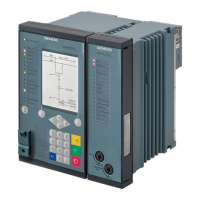•
Measurement of the fundamental comp.:
This method of measurement processes the sampled current values and filters out the fundamental
component numerically.
•
Measurement of the RMS value:
This method of measurement determines the current amplitude from the sampled values according to
the defining equation of the RMS value. Harmonics are included in the analysis.
Voltage-Dependent Pickup Threshold
The pickup threshold of the overcurrent stage depends on the voltage magnitude. A lower voltage decreases
the current pickup value (see Figure 7-138). In the range between V/V
rated
= 1.00 to 0.25 a linear, directly
proportional dependence is realized.
[dwvolpic-220713-01.tif, 1, en_US]
Figure 7-138 Voltage Influence of the Pickup Threshold
With:
V = Measured phase-to-phase voltage
V
rated
= Rated voltage (parameter Rated voltage in the function block General of the protec-
tion function group)
PU sett. = Pickup threshold setting (parameter address: _11491:3)
PU(V) = Applied pickup threshold according to the voltage influence
The minimum current pickup threshold value is 0.03 * Irated. This value cannot be decreased any further even
not by voltage-dependent pickup threshold factor.
Decreasing the pickup threshold is carried out phase-selectively. The assignment of voltages to current-
carrying phases is shown in Table 7-8.
Table 7-8
Controlling Voltages in Relation to the Fault Current
Current Controlling Voltage
I
A
V
AB
I
B
V
BC
I
C
V
CA
Pickup and Dropout Behaviors of the Inverse-Time Characteristic Curve According to IEC and ANSI
When the input variable exceeds the threshold value by a factor of 1.1, the inverse-time characteristic curve is
processed.
Protection and Automation Functions
7.12 Voltage-Dependent Overcurrent Protection
776 SIPROTEC 5, High-Voltage Bay Controller, Manual
C53000-G5040-C015-9, Edition 11.2017

